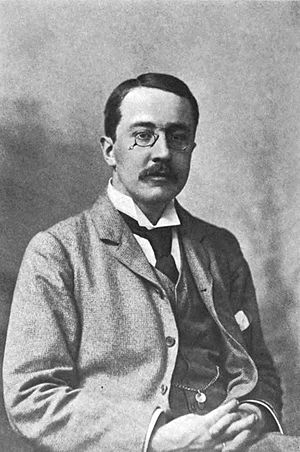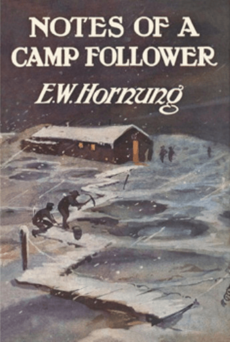E. W. Hornung facts for kids
Ernest William Hornung (born June 7, 1866 – died March 22, 1921) was an English author and poet. He is best known for creating the popular character A. J. Raffles, a clever gentleman thief who lived in London in the late 1800s.
Hornung went to Uppingham School. Because of poor health, he left school in 1883 and traveled to Sydney, Australia, where he stayed for two years. His time in Australia later inspired many of his stories and novels.
In 1898, he wrote "In the Chains of Crime," which introduced Raffles and his friend, Bunny Manders. These characters were partly inspired by Hornung's friends and also by Sherlock Holmes and Dr. Watson, who were created by his brother-in-law, Arthur Conan Doyle. The Raffles short stories were collected into books starting in 1899. Hornung wrote many other books too, from A Bride from the Bush in 1890 to The Crime Doctor in 1914.
The First World War stopped Hornung from writing fiction. His son, Oscar, was killed in battle in July 1915. Hornung then joined the YMCA to help soldiers, first in England and then in France, where he ran a canteen and library. He published poetry during and after the war, along with a book about his experiences in France. The stress of his war work weakened his health. In 1921, while trying to recover in France, he became ill with the flu and died at age 54.
Even though many of Hornung's other works are not well-known today, his Raffles stories are still very popular. They have been made into many films and TV shows. Hornung's stories explored more than just crime; he also wrote about new scientific ideas, feelings of guilt, social classes, and the unfair roles of women in society. Two important themes in his books were Australia and cricket, which he loved his whole life.
Contents
Biography
Early Life and Australia: 1866–1886
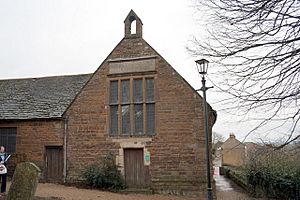
Ernest William Hornung was born on June 7, 1866, in Marton, Middlesbrough. He was the third son and youngest of eight children. His father, John Peter Hornung, was from Transylvania, Hungary, and became a coal and iron merchant in Britain.
At 13, Hornung went to St Ninian's Preparatory School and then to Uppingham School in 1880. He was well-liked and developed a strong love for cricket, even though his eyesight was poor and he had asthma. His health was generally not very good.
When Hornung was 17, his health got worse. He left Uppingham and traveled to Australia, hoping the climate would help him. In Australia, he worked as a tutor for a family and spent time on sheep farms in the outback. He also wrote for a magazine called The Bulletin and started writing his first novel. Even though he was only in Australia for two years, this experience greatly shaped him and his writing career.
Return to England and Early Writing: 1886–1898
Hornung came back to England in February 1886. His father's business had faced problems, and the family was not as wealthy as before. Hornung found work in London as a journalist and writer. He often used a pseudonym (a pen name), but in 1887, he published his first story under his own name. During this time, there was a rise in urban crime in London, which made Hornung interested in criminal behavior.
Hornung continued working on the novel he started in Australia. Between July and November 1890, his story, "A Bride from the Bush", was published in parts in The Cornhill Magazine. It was also released as his first book that year. The story used his knowledge of Australia and featured an Australian bride to explore British society. Critics liked the novel. In 1891, Hornung joined two cricket clubs, where he met other writers like Arthur Conan Doyle.
Hornung knew Doyle's sister, Constance ("Connie") Aimée Monica Doyle. They got engaged by December 1892 and married on September 27, 1893. Their relationship was sometimes difficult. In 1895, the Hornungs had a son, Arthur Oscar, who was known as Oscar. Arthur Conan Doyle was Oscar's godfather.
Like his first novel, Hornung's second book, Tiny Luttrell, was set in Australia and featured an Australian woman in a new culture. His next four novels also had Australian themes. In The Rogue's March (1896), Hornung wrote about Australia's convict system and showed a growing interest in why criminals act the way they do. He even showed sympathy for criminal heroes. Another book, Irralie's Bushranger, introduced Stingaree, an educated Australian gentleman thief who made readers question their ideas about criminals.
Introducing Raffles: 1898–1914
In 1898, Hornung's mother died. He dedicated his next book, Some Persons Unknown, to her memory. Later that year, Hornung and his wife visited Italy for six months. They returned to London in early 1899.
The character Stingaree was a bit like a practice run for A. J. Raffles, whom Hornung introduced in a series of six short stories in 1898. Raffles was partly inspired by George Cecil Ives, a smart criminologist and cricketer. The first Raffles story was published in June 1898. These stories were collected into a book called The Amateur Cracksman the next year, with two extra tales.
Hornung used a storytelling style similar to Doyle's Sherlock Holmes stories. Raffles and his partner-in-crime, Bunny Manders, were like the criminal versions of Holmes and Dr. Watson. Hornung dedicated the stories to his brother-in-law, Doyle. Doyle had warned him not to write the stories, saying that making a criminal the hero could be "dangerous." However, the book was very popular and successful. Some critics agreed with Doyle, worrying that the book made crime seem too appealing. The book ends with Manders in prison and Raffles seemingly dead.
After two other novels, Hornung published a second collection of Raffles stories, The Black Mask, in 1901. In these stories, Raffles returns, looking much older. In the last story, Raffles and Manders join the army to fight in the Second Boer War. The story ends with Manders wounded and Raffles killed. Critics again complained about the criminal hero.
In 1903, Hornung worked with Eugène Presbrey to write a four-act play called Raffles, The Amateur Cracksman. It was based on two of his short stories and was first performed in New York.
In 1905, Hornung brought back the character Stingaree. Later that year, due to public demand, he wrote a third series of Raffles stories in A Thief in the Night. In this book, Manders tells stories of his and Raffles's earlier adventures. Critics found the book "thrilling and exciting." Hornung's last Raffles story was the novel Mr. Justice Raffles in 1909. This book was not well-received, with one reviewer wondering if Hornung was "a little tired of Raffles." He also worked on a play called A Visit From Raffles.
After this, Hornung stopped writing about Raffles. In 1911, he published The Camera Fiend, a thriller about a scientist trying to photograph the soul. This book had a main character who was an asthmatic cricket fan with an ironmaster father, much like Hornung himself. He then wrote Fathers of Men (1912) and The Thousandth Woman (1913). His last work of fiction was The Crime Doctor (1914).
First World War and Later Life
Oscar Hornung, Ernest's son, left Eton College in 1914 and joined the army when Britain entered the war. He was killed at the Second Battle of Ypres on July 6, 1915, at age 20. Hornung was heartbroken but wanted something good to come from it. He edited a private collection of Oscar's letters home, published in 1916.
Around this time, Hornung joined an anti-aircraft unit. In 1916 or 1917, he joined the YMCA and volunteered to help soldiers in England. In March 1917, he visited France and wrote a poem about his experience. A collection of his war poetry, Ballad of Ensign Joy, was published later that year.
In July 1917, Hornung's poem, "Wooden Crosses," was published in The Times. Later that year, he became a volunteer in a YMCA canteen and library near the front lines in France. In February 1918, he visited his son's grave near Ypres. Hornung was concerned about some soldiers' views on peace and wrote to his wife about it. When she told Arthur Conan Doyle, Doyle informed the military, which angered Hornung and strained their relationship.
Hornung continued working at the library until March 1918, when he had to retreat due to fighting. He returned to England and then went back to YMCA duties in November 1918, setting up a rest hut and library in Germany. In 1919, Hornung's book about his time in France, Notes of a Camp-Follower on the Western Front, was published. Doyle later praised parts of the book. Hornung also published his third and final book of poetry, The Young Guard, that year.
Death and Legacy
Hornung finished his YMCA work and returned to England in early 1919. He started a new novel but was held back by poor health. His wife's health was also a concern, so in February 1921, they went on holiday to the south of France. He became ill on the train with the flu and pneumonia and died on March 22, 1921, at age 54. He was buried in Saint-Jean-de-Luz, France. Arthur Conan Doyle, who was returning from a trip, attended the funeral.
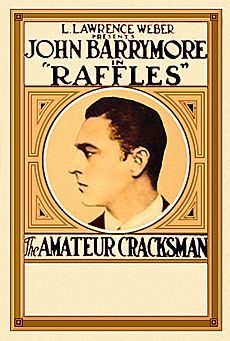
After Hornung's death, much of his work became less popular. However, his Raffles stories continued to be loved. The idea of a criminal as a positive character was one of Hornung's lasting influences. Critics see Raffles as an early example of the "antihero" in crime fiction. Raffles's mix of "devilry and daring" made him a literary "forerunner" to characters like The Saint and James Bond.
Other writers continued the Raffles character in books, with permission from Hornung's family. These new stories changed Raffles from a gentleman thief to a tough adventurer. Hornung's original stories have been reprinted many times. In 1975, Graham Greene wrote a play based on the Raffles stories.
Several Raffles films were made during Hornung's lifetime and after his death. These include Raffles, the Amateur Cracksman (1925), Raffles (1930) starring Ronald Colman, and Raffles (1939) starring David Niven.
The BBC has also created radio dramas of Hornung's Raffles stories. In 1977, Anthony Valentine played Raffles in a TV series. A 2001 TV film, Gentleman Thief, updated the stories for modern audiences.
Writing
Style and Storytelling
People often praise Hornung's writing for being clear and simple. One writer in The Times said that a great part of the Raffles books is their "simple, plain, unaffected language." Another writer admired Hornung's "power of good and clear description and a talent for mystery and surprise." His writing has a good pace, and the stories, even if they seem silly, keep readers interested.
Critics also note that Hornung's stories and novels are well-structured. George Orwell called Hornung a "very conscientious and ... very able writer." Hornung's work improved over his career.
Hornung's way of creating characters was different from other writers of his time. He often wrote from the point of view of the criminal. While many of his novels included crime, they also had elements of general fiction, like false identities, disguises, and hidden heiresses.
Main Ideas in His Stories
Hornung's Raffles stories often explore three main ideas:
- New Women: Raffles sometimes escapes from romantic situations or uses a woman's feelings to achieve his goals.
- Rich People: Raffles steals from both the newly rich and the upper classes.
- Middle-Class Identity: Raffles is not part of "high society" but is accepted because of his cricket skills. His stealing from the rich can be seen as defending middle-class values.
Hornung kept up with new scientific and medical discoveries and liked to include them in his stories. This shows he was interested in modern ideas. For example, The Camera Fiend uses a camera as a key part of the plot, and the main character in The Crime Doctor uses psychology to find criminals.
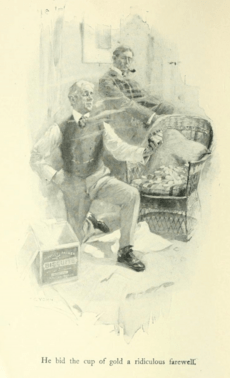
Patriotism is a recurring theme in the Raffles stories. In "A Jubilee Present," Raffles celebrates Queen Victoria's diamond jubilee by stealing a gold cup from the British Museum and sending it to the queen. In "The Knees of the Gods," Raffles volunteers to fight in the Second Boer War, even joking that he is ready to "dye for his country."
Some of Hornung's novels, like The Shadow of the Rope and The Thousandth Woman, are known for showing women in a modern and positive way. They highlight concerns about women's unequal place in society. Hornung also explored the theme of guilt in several works. For example, in Peccavi, a clergyman tries to make up for a past crime, and in The Thousandth Woman, a woman supports her lover after he is accused of murder.
Even though Hornung's time in Australia was short, it influenced most of his writing, from his first novel to books published after his death. Nearly two-thirds of his books mention Australian events or experiences. Some of his works were praised for their accurate details about Australia.
Cricket was a lifelong passion for Hornung, and he became a member of the Marylebone Cricket Club in 1907. The sport also appeared in his stories, with Raffles playing for the Gentlemen of England. Raffles often compares breaking the law to cricket, seeing crime as "another and better sport." He even says, "where's the satisfaction of taking a man's wicket when you want his spoons?" Raffles uses cricket as a cover for his criminal activities, praising it for the "glorious protection it affords a person of my proclivities."
Raffles's actions are often seen within a code of "sportsmanship," where he follows his own rules about what is "done" and "not done." When Raffles feels bad about something, it's usually because he feels he has disgraced his "old school" or lost his right to be part of "decent society."


